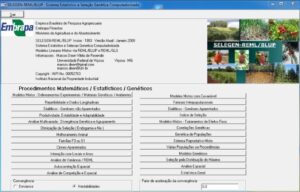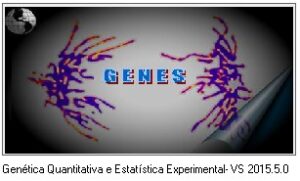SOFTWARES
Rbio (download – click here):
Updates: Uninstall the previous version and install the new one
Installation Tutorial (click here):The Rbio program is a software for data analysis and processing, using software R. It is extremely user-friendly software and it is not necessary to know how to program in R. In addition, each procedure provides the scripts used, so That the user can edit them if necessary, thus making it an excellent tool for teaching programming in R. It has a basic statistical module where you can explore the data by descriptive statistics, normality tests, correlation between pairs of Variables, regression. It has a variance analysis module for DIC, DBC, QL, Látice, or rearrangements in factorial, hierarchical and subdivided plot, as well as means tests and Scott-Knott grouping, with test for normality and variance homogeneity. It also has a multivariate analysis module to obtain distance matrix and later grouping, as well as main components, factor analysis, manova, canonical correlations and discriminant analysis. The non-parametric analysis module has the Friedman, Kruskall-Wallis, Wilcoxon test for 1 sample or several matched or not paired samples, in addition to Spearman and Kendall correlations. It also has tool of simulations of samples and experiments, as well as draw of experiments. It also performs biometric analyzes of adaptability and stability and bioinformatics analyzes as DNA sequence statistics.
Citação: Bhering, L.L. Rbio: A tool for biometric and statistical analysis using the R platform. Crop Breeding and applied biotechnology. v.17:187-190p. 2017. Download paper
Installation Tutorial (click here)
The GENES program is software for the analysis and processing of data through different biometric models. It has uni and multivariate procedures, performing processing with emphasis on the estimation of genetic parameters. It has three basic modules: 1) Experimental statistics (analysis of variance, test of means, regressions and correlations); 2) Biometry (interaction genotypes x environments, adaptability, stability, selection index, combined selection, diallel analysis, generation analysis and repeatability); 3) Multivariate analysis (main component, canonical variables, canonical correlations, discriminant functions, factor analysis, dissimilarity measures with quantitative and binary variables and cluster analysis).
Citação: Cruz, C.D. GENES – a software package for analysis in experimental statistics and quantitative genetics. Acta Scientiarum. v.35, n.3, p.271-276, 2013

Selegen Reml/Blup Selegen software was developed to support the genetic improvement of forest species; However, it can be used for other perennial or semi-perennial plant species and animals, in which the selection of individuals prevails over the selection of groups of individuals. The program is based on algorithms that maximize the efficiency of the selection process, by comparing several selection methods, with a view to different experimental situations. The software maximizes the efficiency of breeding programs of various plant categories: – forest species (such as eucalyptus, pinus, black wattle, rubber tree, leucaena, grevílea, teak, mahogany); – stimulant food producing species containing the alkaloids caffeine and theobromine (coffee, cocoa, yerba mate, guarana, guava, tea); Palmáceas, palmito, edible fruit oils (such as palm, coconut, peach palm, açaí, juçara, palm tree, palm-tree); – fruit trees (acerola, cashew, cupuaçu, apple, graviola, pineapple); – forage plants (such as elephantgrass, brachiaria, panicum, stylers, alfalfa); – energy species (such as sugarcane, manioc); – horticultural or vegetable species (such as potatoes, strawberries); – annual species (grain producers, such as cereals and others).
Métodos Estatísticos de Seleção Genômica Ampla
Software R:R is ‘GNU S’, a freely available language and environment for statistical computing and graphics which provides a wide variety of statistical and graphical techniques: linear and nonlinear modelling, statistical tests, time series analysis, classification, clustering, etc. Please consult the R project homepage for further information.
GBOL: Installation Tutorial (click here): The GBOL program was developed with the purpose of being an auxiliary instrument for the teaching and learning of Basic Genetics topics. It has illustrations, photos and simulations allowing the presentation of exercises in a randomized way, for efficient and enjoyable learning. Topics of classical genetics, mutagenesis, cytogenetics, molecular, quantitative and population genetics are discussed.



